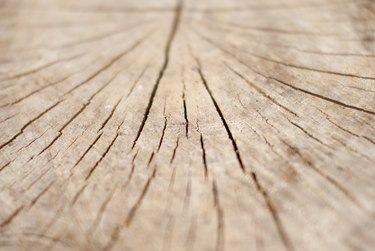
Comparisons between oak and hickory should include both types of oak: red and white. Even though the three types of wood are used in a similar manner, differences in hardness, density, grain patterns and color can affect the final outcome. The differences between oak and hickory are typically defined by application. Oak and hickory produce dust that can cause health issues. Always wear breathing and eye protection.
The Hardness Scale
Video of the Day
The Janka scale rates hardness or density of hardwoods: the higher the number, the harder or more dense the wood. Hickory is the hardest of the three types with a rating of 1,820. White oak is second with a rating of 1,360. Red oak is the softest of the three at 1,290. For the sake of comparison, Brazilian walnut or ipe, has the highest Janka rating at 3,684. At the low end of the scale, white pine has a rating of 380. Hardness and density also affect weight and workability. Hickory is harder on your hands, fingers and back.
Video of the Day
Equipment Issues
Choosing hickory over oak means you'll need better blades that need sharpening more often. Hickory blunts ordinary woodworking saw blades. Carbon-tipped blades are recommended for hickory, while high-speed steel blades are typically sufficient for oak. Shooting or driving nails into hickory requires more force than oak does. If nails or screws break off in hickory they can be more difficult to remove than they would be in oak. Pilot holes for screws and nails -- when the nails are driven by hand -- are also recommended when using hickory. Hickory is more likely to split or splinter than oak. Drills, planers, stationary sanders and all automatic feed equipment should run at slower speeds when using hickory, compared to oak. Hickory produces a finer, more powdery dust than oak when cut or milled. Oak produces a coarse sawdust that doesn't become airborne as easily when cut or milled. Breathing and eye protection should be worn when working with any kind of wood,
Grain Differences
The grain patterns of the three species have subtle, yet distinctive, differences. Red oak has a broad grain pattern that might zig-zag, look similar to a lighting bolt with sharp edges, run in straight, close lines or combine all the above. Red oak ranges from light amber to brown to a slight pink. Hickory ranges from mostly gray to off-white to dark brown and cream with streaks of purple -- all on the same board. The hickory grain pattern is tight and mostly straight, but it can boldly wander from the straight lines, forming triangular patterns that come to a sharp point. Due to differing grades, hickory might also have knots and defects, which some woodworking enthusiasts prize for a rustic appearance. One defining feature separates white oak from hickory or red oak: White oak has a pleasant, perfume scent when freshly cut.
Applications
Red oak is the most widely used of the three species. It's more available and more affordable that white oak or hickory. Red oak is used traditionally for cabinets and interior trim work. Red oak plywood is readily available. White oak and hickory plywood are more exclusive than red oak plywood, and may have to be specially ordered. White oak is typically used more often for furniture and specialty projects. Old-world craftsmen prized white oak for tables, chairs and chests. The amount of white oak antique furniture still in existence testifies to the wood's widespread use around the early 1900s and before. Hickory is typically used less for cabinetry than are red or white oak, due in part to its higher cost, and it can be harder to find. Hickory has a higher stress rating than red or white oak. Its resiliency has made it a popular choice for handles on such things as axes, shovels, hammers, rakes and baseball bats. It's also popular for flooring and fine furniture.
Finishing
Finishing issues between oak and hickory are based on preparation. It takes more time to sand hickory than oak because it's harder. Scratches are harder to remove from hickory than oak, especially if the scratches run perpendicular to the grain. Typically, hickory must be sanded with successively smaller grits to achieve the same smoothness achieved with less effort than sanding either type of oak. Oak finish preparation is often complete with a final sanding using 100-grit sandpaper. Hickory preparation typically requires a final sanding using 120- to 180-grit sandpaper to get it ready for stain. Finishing with stain is also a differentiating factor between the two species: Due to hickory's hardness, stain penetrates it more slowly than it does oak. The stain must remain on the surface of hickory longer than oak to achieve the same color. Once the stain has dried, top coat preparation is much the same among all three.